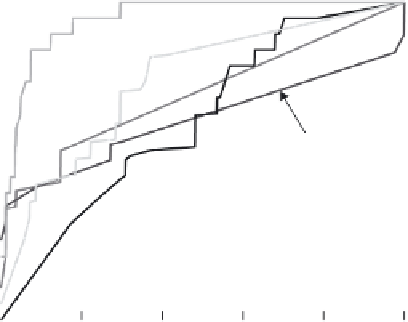Information Technology Reference
In-Depth Information
1
SERA
0.8
REA
0.6
Normal
SMOTE
UB
0.4
0.2
0
0
0.2
0.4
0.6
0.8
1
(d) ROC curves of algorithms in comparison
for the 40th data chunk of ELEC dataset
Figure 7.9
(
Continued
)
to adaptively tune its inner parameters constantly in order to catch up with the
continuous updates of class concepts.
Following the procedure given in [32], the number of dimensions for the
feature set of SHP dataset is deemed to be 10 and the magnitude of change
t
is set to be 0
.
1. The number of chunks is set to be 100 instead of 40 as for
the previous two datasets, as we would like to investigate REA in longer series
of streaming data chunks. Each data chunk has 1000 examples as the training
dataset and 200 instances as the testing dataset, that is,
N
1200. In addition to
the normal setup of the imbalanced ratio being 0
.
05 and noise level being 0
.
01,
other suites of datasets are generated when the imbalanced ratio is 0
.
01 and noise
level is 0
.
01, and yet another when the imbalanced ratio is 0
.
05 and the noise
level is 0
.
03. In this way, the robustness of all algorithms under comparison that
handle more imbalanced dataset and more noisy datasets can be evaluated. In the
rest of this section, the three different setups of imbalanced ratio and noise level
are referred as
setup 1
(imbalanced ratio = 0
.
05 and noise level = 0
.
01),
setup 2
(imbalanced ratio = 0
.
01 and noise level = 0
.
01), and
setup 3
(imbalanced ratio
=0
.
05 and noise level = 0
.
03), respectively.
Similar to the procedure for the previous two datasets, the results of all com-
parative algorithms on an SHP dataset are based on the average of 10 random
runs. The observation points are placed in data chunks 10, 20, 30, 40, 50, 60,
70, 80, 90, and 100.
Figures 7.10-7.12 plot the tendency lines of OA and AUROC for comparative
algorithms across observation points under
setup 1
,
setup 2
,and
setup 3
, respec-
tively. One can see that in terms of both OA and AUROC, REA consistently
outperforms all algorithms all the time. In terms of AUROC, UB and SERA
compete with each other for the second place after REA in different scenarios,
that is, different imbalanced ratios and different noise levels.
=


















Search WWH ::

Custom Search